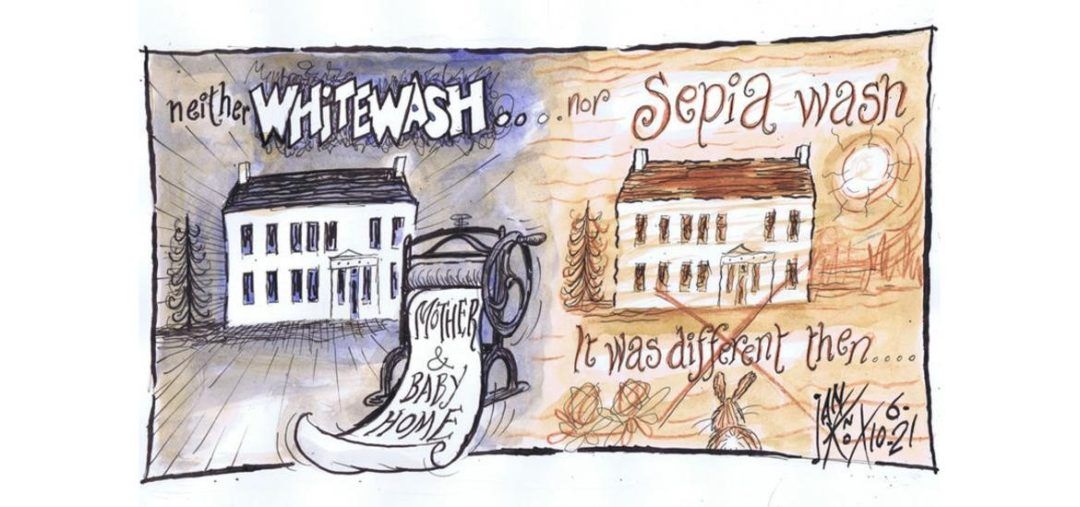Ian Knox cartoon 6/10/21 in The Irish News
What do we see here?
This cartoon by Ian Knox was published in the cartoon section of the opinion column in The Irish News in October 2021. The watercolour, painted in black, blue and sepia, is divided into a left and right panel with each side showing the same stately home nestled in the countryside. The house on the left is bright white with soft black details in a clean confident style. All around the house we see bursts of lines radiating outward, drawing the eye to the shining white house centred on a background coloured with a wash of blue-gray. In the foreground we see a mangle to wring wet laundry, which is rolling out a cloth baby diaper with the words Mother & Baby Home. The house on the right is generally white though the wash of orange-brown (sepia) from the background moves across the house in soft horizontal lines. The sky behind the house is washed in orange with horizontal rays emanating from a broiling sun. A cotton-tailed bunny is sitting next to the sepia-toned flowers in the foreground, watching the home from afar.
Which public issue is being addressed here?
The cartoon is referring to the terrible living conditions at the homes for unwed mothers and their babies in Ireland during most of the 20th century. The Irish government recently published the findings from its inquiry into the matter which estimates that 56,000 women were kept in coercive confinement in these homes from 1922 to 1998. These institutions experienced a shockingly high mortality rate with infants and children dying from malnutrition and disease, but no records were kept on the location of the graves or the unorthodox burial practices. There is concern over the fate of the information collected by the investigating commission and whether it will be made available to those who are still suffering from being mistreated at these homes or whether the documents will be sealed in government archives for the next 30 years.
What does the humour do?
This satirical vignette relies on subtly entwined multimodality to create layers of meaning ‘hidden’ behind a verbal caption that plays with the monotone washes of colour, to convey a harsh message of contempt that slowly develops when the words, the colours and the hand-drawn signals combine to create another interpretation of whitewash, sepia-toned and freshly washed laundry coming out of the wrangle.
The overlapping and opposing scripts, that the General Theory of Verbal Humor tells us can emerge, center on a pun with the word whitewash. Whitewash is a type of white paint that was used on buildings (the house is white) and it also means to cover up or conceal a criminal act (the abuse in these institutions was concealed for decades). Yet we are also told, through the mangle squeezing the clean diaper, that ‘it will all come out in the wash’ meaning that eventually we will discover any secrets. And finally, the recognizable reddish-brown colour of early sepia-toned photographs commonly carries a notion of nostalgia or a yearning for the past when life was better. This idea is immediately negated by the large x over the words ‘It was different then…’ to rebut the possible argument that we cannot or should not judge the past through the morals of today as there can be no excuse for this type of abuse. Using a cartoon to criticize these institutions, allows the message to arise from the semiotics of the whole where two different meanings are superimposed.
